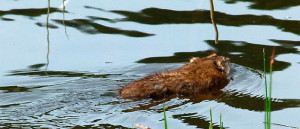While searching for “best muskrat poison” may seem like the quickest solution to your muskrat problem, the reality is that poison is rarely the safest or most effective approach. Muskrats are semi-aquatic rodents that can cause significant damage to ponds, waterways, and landscaping through their burrowing and feeding activities. This comprehensive guide will explain why poison isn’t recommended for muskrat control and provide you with proven, safer alternatives that actually work better.
Quick Picks: Best Muskrat Poison Alternatives

Editor’s Choice
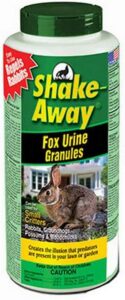
Natural Deterrent

Humane Solution
Why Muskrat Poison Isn’t Recommended
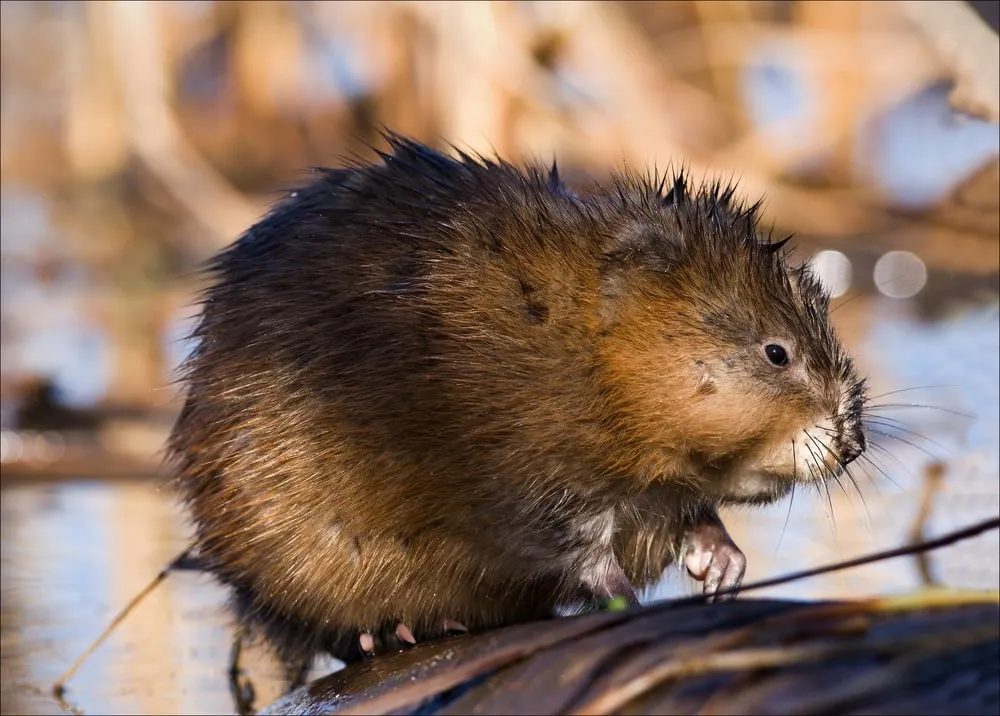
There are no commercially available poisons specifically designed for muskrats. Using off-label rodenticides is dangerous, often illegal, and poses serious risks to humans, pets, and wildlife.
Many homeowners facing muskrat infestations consider poison as a quick fix, but this approach comes with significant drawbacks that make it an impractical and dangerous choice.
Legal and Regulatory Issues
Rodenticides are heavily regulated by the Environmental Protection Agency (EPA) and state wildlife agencies. Using these products off-label or in waterways is typically prohibited and can result in substantial fines. Many states require professional licensing to apply certain rodenticides, and some have banned specific products entirely due to environmental concerns.
Environmental Contamination Risks
When poisoned muskrats die in water sources, they contaminate the entire aquatic ecosystem. This contamination can:
- Affect Water Quality: Decomposing carcasses release toxins into ponds, streams, and groundwater
- Harm Non-Target Wildlife: Secondary poisoning occurs when predators and scavengers consume poisoned muskrats
- Create Health Hazards: Contaminated water poses risks to pets, livestock, and humans who may come into contact with it
Practical Problems with Poison
Beyond safety concerns, poison presents several practical challenges:
Difficult Retrieval
Poisoned muskrats often die in water or underground burrows, making carcass removal nearly impossible.
Slow Acting
Most rodenticides take days to work, during which muskrats continue causing damage and may travel far from the treatment area.
Disease Risk
Muskrats can carry diseases like leptospirosis and tularemia, making carcass handling dangerous without proper protective equipment.
Understanding Muskrat Behavior and Damage
Before exploring control methods, it’s essential to understand what attracts muskrats to your property and the type of damage they cause.
Common Muskrat Damage Types
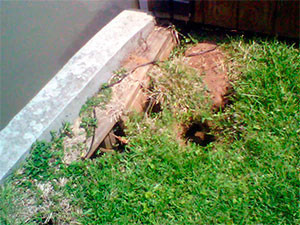
Bank erosion from extensive burrowing
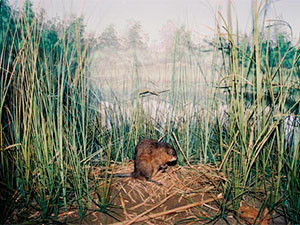
Decimated aquatic plant life
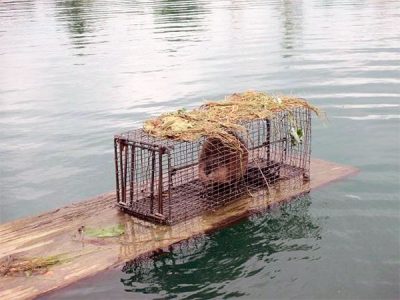
Feeding platforms near water’s edge
Muskrats are drawn to areas that provide food, shelter, and water. They prefer calm waters with abundant vegetation like cattails, sedges, and water lilies. Once established, they reproduce rapidly, with females producing 2-3 litters per year of 4-8 young each.
Proven Alternatives to Muskrat Poison
Instead of relying on dangerous poisons, these evidence-based methods provide safer, more effective muskrat control:
1. Live Trapping (Most Effective Method)
Havahart Large Live Animal Trap
Editor's ChoiceHow Does It Work
How to Use
- Place traps on feeding platforms or along well-worn muskrat paths
- Use natural baits like carrots, apples, or cattail roots
- Check traps every 4-6 hours to minimize stress on captured animals
- Relocate at least 5 miles away in suitable wetland habitat
- Humane and effective removal method
- Reusable for ongoing muskrat problems
- No risk of secondary poisoning
- Allows for immediate problem resolution
- Requires regular monitoring and maintenance
- May need multiple traps for large populations
- Relocation requires suitable release sites
Live Trapping Success Tips
- Place traps perpendicular to the shoreline for best results
- Use pre-baiting (leaving bait without setting the trap) for 2-3 days to build confidence
- Camouflage traps with natural vegetation to reduce wariness
- Position traps where muskrat droppings are visible
2. Natural Deterrents and Repellents
Predator Pee Fox Urine
Natural DeterrentHow Does It Work
How to Use
- Apply every 10-15 feet around affected areas
- Reapply weekly or after heavy rain
- Focus on feeding areas and burrow entrances
- Use in combination with other deterrent methods for best results
- Completely natural and non-toxic
- Safe for use near water sources
- Doesn't harm muskrats or other wildlife
- Easy to apply with included sprayer
- Requires frequent reapplication
- Effectiveness varies with weather conditions
- May take several weeks to show full effect
3. Motion-Activated Deterrents
Orbit Motion-Activated Sprinkler
Humane SolutionHow Does It Work
How to Use
- Install 6-8 feet from the water's edge for optimal coverage
- Adjust sensitivity settings based on local conditions
- Move units periodically to prevent habituation
- Use multiple units for larger properties (one every 30-35 feet)
- Completely humane and non-toxic
- Solar powered with battery backup
- Works 24/7 without human intervention
- Effective against multiple pest species
- May be triggered by non-target animals
- Requires periodic cleaning and maintenance
- Less effective in winter conditions
4. Habitat Modification Strategies
Making your property less attractive to muskrats is one of the most effective long-term solutions:
| Modification Type | Method | Effectiveness | Cost |
|---|---|---|---|
| Vegetation Management | Remove cattails, sedges, and water lilies | High | Low-Medium |
| Bank Modification | Create steep, rocky shorelines | Very High | Medium-High |
| Water Aeration | Install pond aerators to disrupt calm water | Medium | Medium |
| Physical Barriers | Install 1-inch mesh fencing below waterline | Very High | High |
Check local regulations before modifying natural water sources. Wetland areas may be protected and require permits for alterations.
5. Professional Exclusion Systems
For severe infestations or valuable water features, professional-grade exclusion systems offer the most reliable long-term solution:
- Underwater Fencing: Professional installation of galvanized mesh barriers 3 feet below water level
- Bank Reinforcement: Strategic placement of riprap or other materials to prevent burrowing
- Integrated Management: Combination of multiple methods tailored to your specific situation
When to Call Professional Help
Consider professional wildlife control services if:
Large Populations
Multiple family groups or extensive burrow systems require professional assessment and removal strategies.
High-Value Property
Expensive landscaping or critical infrastructure needs protection from ongoing damage.
Legal Restrictions
Protected wetlands or local ordinances limit your control options.
Preventing Future Muskrat Problems
Once you’ve resolved your current muskrat issue, these strategies will help prevent reinfestations:
Prevention Best Practices
- Conduct monthly inspections of water features for new activity signs
- Maintain vegetation management year-round
- Address beaver activity promptly, as muskrats often follow
- Keep detailed records of control efforts for future reference
Cost Comparison: Poison vs. Safe Alternatives
| Method | Initial Cost | Ongoing Cost | Hidden Costs | Total First Year |
|---|---|---|---|---|
| Illegal Poison Use | $50-100 | $200-400 | Fines ($1,000-10,000), Cleanup ($500-2,000) | $1,750-12,500 |
| Live Trapping | $80-150 | $50-100 | Time investment | $130-250 |
| Deterrent System | $200-500 | $100-200 | None | $300-700 |
| Professional Service | $500-1,500 | $200-500 | None | $700-2,000 |
Frequently Asked Questions
Is there any legal muskrat poison available?
No, there are no EPA-approved poisons specifically designed for muskrats. Using off-label rodenticides for muskrat control is typically illegal and dangerous.
Professional wildlife control operators may have access to specialized baits, but these require licensing and are not available to homeowners.
How quickly do alternative methods work compared to poison?
Live trapping can remove muskrats within days, while deterrents typically show results within 2-4 weeks. Poison, if it were legal, would take 3-7 days but create additional problems with carcass disposal and environmental contamination.
Integrated approaches combining multiple methods often show faster results than any single method alone.
What attracts muskrats to my property?
Muskrats are attracted to calm water with abundant vegetation like cattails, sedges, water lilies, and arrowheads. They also prefer areas with soft banks suitable for burrowing and minimal human disturbance.
Properties with existing beaver activity are particularly attractive since muskrats often share beaver lodges and benefit from their habitat modifications.
Can I relocate trapped muskrats myself?
Relocation laws vary by state and locality. Many areas require permits for wildlife relocation or specify minimum distances (typically 5+ miles) from the capture site.
Check with your state wildlife agency for specific regulations. Some areas prohibit relocation entirely due to disease transmission concerns.
How do I know if muskrats are causing my pond damage?
Look for burrow entrances in banks below the waterline, feeding platforms made of vegetation debris, and distinctive V-shaped wakes when swimming. Muskrat droppings are cylindrical and often found on logs or feeding platforms.
Damaged vegetation will show clean cuts rather than the rough tears typical of other herbivores.
Are muskrats dangerous to pets or children?
Muskrats are generally not aggressive but will defend themselves if cornered. They can carry diseases like leptospirosis and tularemia, so direct contact should be avoided.
The main risk to pets is from unstable banks weakened by muskrat burrows, which could collapse under weight.
Do ultrasonic devices work against muskrats?
Scientific studies show mixed results for ultrasonic devices against muskrats. These semi-aquatic animals spend much of their time underwater where sound waves are less effective.
Motion-activated sprinklers and predator scents have proven more reliable for muskrat deterrence.
Can I prevent muskrats without harming other wildlife?
Yes, many effective muskrat control methods are wildlife-friendly. Live trapping, habitat modification, and natural deterrents don’t harm non-target species.
Avoid methods that could affect other wildlife, such as broad-spectrum repellents or modifications that eliminate beneficial habitat features.
Conclusion
While searching for “best muskrat poison” is understandable when facing property damage, the reality is that poison creates more problems than it solves. Legal restrictions, environmental risks, and practical challenges make poison an impractical choice for muskrat control.
The alternatives outlined in this guide—live trapping, natural deterrents, habitat modification, and professional services—offer safer, more effective solutions that protect your property while preserving environmental health. By implementing an integrated approach combining multiple methods, you can achieve long-term muskrat control without the risks associated with toxic substances.
Successful muskrat management requires patience and persistence. Most effective programs combine immediate removal techniques with long-term prevention strategies for lasting results.
If your muskrat problem persists despite trying these methods, consult with a licensed wildlife control professional who can assess your specific situation and recommend targeted solutions that comply with local regulations while protecting your property investment.
